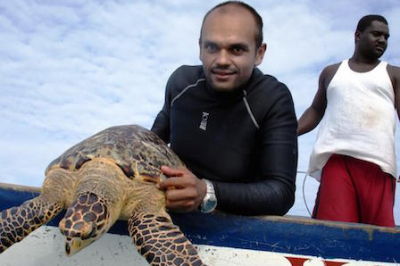“The way MCS and partners worked diligently with our fishermen over several years to develop these recommendations was very welcome, and means that the new measures are reasonable, proportionate, and will help protect our turtle resource. We are looking to use the same stakeholder engagement methods to address other pressing marine conservation issues here in TCI,” Kathleen Wood, SWA Ltd Turks and Caicos Islands, former Director of TCI Government’s Department of Environment and Maritime Affairs
The TCITP is a collaboration between the MCS, the TCI Government’s Department of Environment and Coastal Resources (DECR), The University of Exeter, Duke University, The School for Field Studies South Caicos and the Amanyara Resort.
Bright Spot Description:
Launched in 2008, the Turks and Caicos Islands Turtle Project (TCITP) is a multidisciplinary and collaborative initiative led by the UK’s Marine Conservation Society (MCS). It combines cutting-edge biological and social science, as well as extensive stakeholder engagement, to improve the management of the islands’ traditional marine turtle fishery. This fishery lands approximately 500-600 green and hawksbill turtles annually, and prior to this project, the occasional harvest of adult turtles was hindering the recovery of the islands’ genetically unique but highly depleted breeding turtle populations. Through the use of novel stakeholder engagement tools, including the film-based Community Voice Method, the TCITP fully engaged initially skeptical turtle fishing communities in the policy decision-making process, and combined their needs and desires with the results of the biological and social research to develop informed and balanced recommendations to amend the turtle fishery regulations. The recommended regulations were approved by the TCI government and endorsed by the fishing communities, and came into force in July 2014. This new fishery management regime acknowledges traditional rights to this resource, but protects large and breeding adult turtles in order to allow population recovery in TCI and the Caribbean region.
What makes it bright?
- Development and enactment of contemporary and informed legislation designed by fishers that enables sustainable use of a culturally important resource while protecting large and adult breeding turtles.
- Cutting-edge and multi-disciplinary project methodologies, including CVM film-based community engagement and satellite tracking technology, closely involving fishers in every aspect of project research, community engagement and outreach. TCI fishers had not previously been systematically engaged in fisheries policy development, so the TCITP approach enabled fisher empowerment, ownership and responsibility with respect to their role in creating new policy. Some fishers began voluntarily complying with the recommended turtle fishery measures before they came into force.
- Through CVM, use of a widely appreciated and accessible format (film - https://vimeo.com/80982426) created an enjoyable environment within which complex issues were discussed. CVM thus facilitated the genuine participation of over 270 fishers and community members in shaping their turtle fishery policy through a creative, participatory engagement approach. The outcomes of the process, i.e. the new regulations, were further promoted in another well-appreciated format, namely through 600 humorous t-shirts.
- Through TCITP’s multi-sectorial approach, relationships between turtle fishers and high-end resorts were cultivated resulting in eco-tourism ventures where hotel guests fund and participate in exciting turtle research boat trips while experiencing authentic TCI culture through their fisher hosts. Participating turtle fishers have seen their livelihoods diversified while becoming ambassadors for the project within their community.
- The TCITP pioneered CVM outside of the USA for the first time, and its success in TCI led to MCS successfully trialing CVM in England for the first time to develop stakeholder involvement in marine protected area management. There is a strong desire within TCI fishing communities and other stakeholders groups to see the TCITP approach applied to other fishery and marine stewardship issues.
What are the essential elements that made it successful?
- Clear objectives with open-minded, adaptable approach;
- Respect for stakeholders’ needs, views and cultures, while trying to ensure all stakeholders benefit from engagement (or experience minimal negative impacts)
- Government commitment to stakeholder participation and outcomes;
- Multi-disciplinary ethos and expertise, with strong working partnerships;
- Resources – time, money, patience & expertise.
“Thanks. Respect. You did a nice thing. You care. People trust you now.” South Caicos turtle fisherman to TCITP Project Officer.
Focal Point
Dr. Peter Richardson, Biodiversity and Fisheries Programme Manager, Marine Conservation Society (MCS). Tel. +44 (0)1989 561592, cell: +44(0)7793 118383, e-mail: This email address is being protected from spambots. You need JavaScript enabled to view it.
Related Links
- Turks and Caicos Islands Community Voice Method film – https://vimeo.com/80982426
- Papers (www.seaturtle.org/mtrg/pubs)
- Local TCI Press
- http://www.timespub.tc/2009/06/a-promising-prognosis/
- http://www.timespub.tc/2010/04/the-incredible-journey/
- http://www.timespub.tc/2011/01/turtle-travels-unraveled/
- http://www.timespub.tc/2012/10/go-gilbert-and-david/
- http://www.mcsuk.org/conservation_in_action.php/Marine+turtles/Tracking+turtles/Tracking+turtles+in+the+Caribbean


